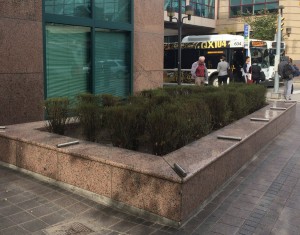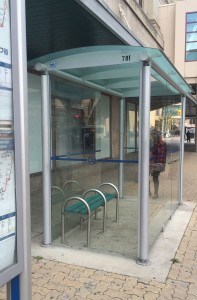I recently read an article about hostile architecture and began to wonder about my own city. I’d noticed the trend before in Winnipeg but foolishly, although I should have known better, I hadn’t viewed it as a movement. As our cities grow more crowded, and our sensibility more corporate, we find our public image increasingly concerned with the presence of the poor. Although Medicine Hat’s Housing First project proved it was cheaper to house people than to deal with the fallout of homelessness and Dauphin, Manitoba’s minimum income project of the Seventies showed poverty to be manageable by policy, few cities have followed suit. Instead, we have chosen to believe that the poor deserve to starve and shiver every bit as much as the wealthy deserve to golf and wolf down caviar.
This way of thinking has extended to our cities. The more recent high profile cases, such as the Olympics in Rio over the summer, snatched back rather than extended the hand that feeds them by ensuring that poverty stricken neighbourhoods are either hidden, or worse, suffer the violent attention of the city authorities when the tourists come to watch people jump and stretch. Likewise, Vancouver landlords took advantage of the 2010 Olympic mania to raise rents beyond what even working people could afford in that already expensive city. In the 2010 Commonwealth games in New Delhi, there was anything but common wealth. Child labour was used in construction of the sites, with some labourers as young as seven, and brothels brought in thousands of sex trade workers and some kidnapped girls in anticipation of the boom in the sex trade. Some brothels even paid for English classes so the prostitutes could communicate with their foreign johns.
When Winnipeg hosted the 1999 PanAm games, the situation was similar; the poor were heartily encouraged by police presence to leave the downtown to their betters, and in architectural terms, crossing Main Street was prevented by decorative fencing. This was the first time I heard of architecture being used against the citizens, or at least against some of them. We have all heard the loud classical music played where young people congregate, and observed pronounced police presence at events and parades, but deforming the construction of public space, using the public purse to make our cities less livable, is an animal of an entirely different kind.
I have by no means exhausted all the options that Winnipeg offers, but I will post occasionally what I discover about this city 
 that reels from its poverty, even as it fights back by attacking its most vulnerable.
that reels from its poverty, even as it fights back by attacking its most vulnerable.
We have all seen ledges that might provide public seating barred from skateboarders. This also happens to planters in from of Portage Place mall where many people wait for the bus. There is seating inside for fifteen people out of the dozens who might be waiting, but in case some choose to sit on the concrete planter surround, the city has decorated them. The seating in bus stops is divided in case someone might lie on the seat, or share a seat with someone. These small changes to our urban space are happening around us, ostensibly with our agreement, for as long as we refuse to see the city being walled against its citizens, they will keep blocking us from sitting, lying, and playing in the spaces we have paid for.
